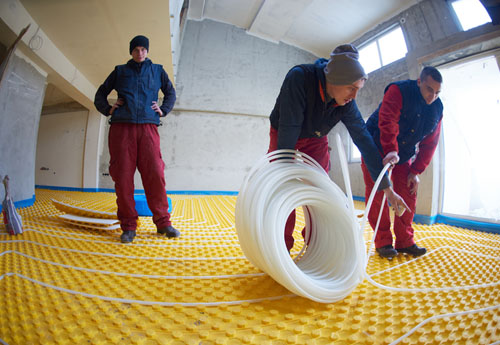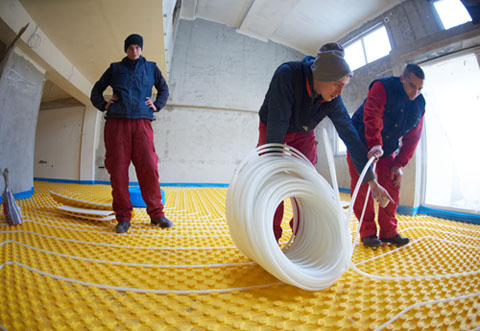The use of radiators were the most common form of heating up buildings until the advent of under floor heating systems. This method dates back to 5,000 BC in Korea and Manchuria where there was evidence of baked floors initially called Dikang meaning’ heated floor’ and Ondol meaning ‘warm stone’. And over the years, several forms of heating floors have been adopted.
In recent times, electric (or dry systems) and hot water (or wet) systems are the major procedures carried out for under floor heating. Wet systems use warm water that is usually pumped through pipes that are laid on the floor before being covered by a special heat-conducting screed which once warm efficiently retains heat. Dry systems use a series of wires or electric heating sheets that are installed beneath the floors and are usually placed on top of a layer of screed )to ensure the surface is completely flat) and a layer of floor insulation to ensure the heat travels upwards and not downwards. The under floor heating system does the same work as a radiator except it heats from the lower room to the upper room.
Like many systems and devices, the under floor water system has its own pros and cons. Below is a table showing a test of the pros and cons of under floor heating.

These heating systems are relatively cheap to install and unlike the standard radiators, the system seldom requires maintenance and so cuts down cost of maintenance. On the plus side, they also require 15-40% less energy than radiators and particularly when connected to a renewable energy source reduces the amount of heating bills.
The heating systems are designed to last for a very long time spanning to a couple of decades. This is ensured with proper maintenance and use since they are built underground and are hardly seen and touched.
With just a radiator as your central heating system, floors often remain cold and damp after it has been turned off. This creates a very habitable ecosystem for critters such as mites and silverfish. The heating system causes the floor to be uninhabitable for these critters by keeping the floor constantly warm and dry making it difficult for them to live and breed in.
Studies have shown that under floor heating systems can reduce the number of dust mites present in floors by up to 80%. And a cleaner floor ensures better health for individuals especially asthma patients.

Contrary to popular belief, under floor heating systems can be installed In a vast majority of floor types provided the correct system is chosen. It is now being used on stone floors, vinyl, engineered wood, carpets (below 1.5 Tog), laminate floors and linoleum.
Unlike the radiators which work by convection and there is no even distribution of heat around the room, under floor heating works by radiation which brings about comfort in the house because the heat is evenly distributed and consistent around the room. Therefore, you can enjoy the heat from any part of the room and do not have to stay close to the radiators for warmth. Plus it is much quieter than radiators that are constantly groan and make whirring noises when it warms up.
Installing under floor heating systems offer more wall and floor space in the room because they are hidden unlike radiators. And so your room is spaced enough for your decorations without the radiators distorting their beauty and there are less clusters.
The electric heating system is considerably cheaper than the wet system heating. Several models are available at stores for you if you prefer to do it yourself and so cost of installation is minimal. Though it is advised to hire the services of a professional electrician to connect the system to the main electricity supply, fit a sensor to the thermostat and sign off the project.
For each room with under floor heating, there are thermostats attached that regulate the room temperature. Hence, there is no reason for one room to be kept as warm as others if not required. You can decide to keep the temperature low in unused rooms or even turn them off. This is also a way of conserving heating bills cost.
Under floor heating systems helps in the evaporation of dangerous water spills in most bathrooms and kitchen tiles. This leaves the floor dry at all times and so uninhabitable for drain larvae/flies. It also minimizes the risk of falling and damage of tiles as a result of wet sand underneath.
With under floor heating, your children can roam the roam freely without constantly worrying about them coming in contact with wires that could electrocute them. A warm floor is also ideal for crawling babies even when the weather temperature is very cold.
Some furniture and fittings cannot be placed on floors with heating systems and this can restrict your home arrangement pattern. It is largely advised to avoid large and heavy furniture and other heavy items on such floors for the system to last longer and cut down maintenance costs. Goods housed in rooms with under floor heating are likely to get damaged depending on their temperature requirements.
Although the cost for installation is relatively cheap, poor maintenance of your floors can incur huge costs when damages occur. In most cases, the floor is demolished completely for reinstallation and repairs. These extra activities cause an increase the cost incurred for maintenance. Retrofitting can also be difficult to carry out.